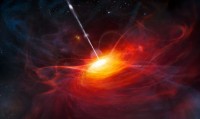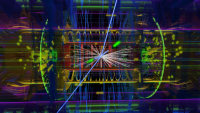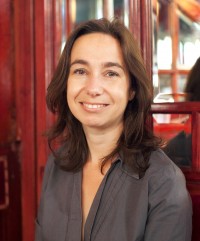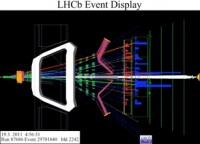
This post by Jon Hill, Imperial College London first appeared on EPCC's blog.
I always jump at the chance to work with EPCC because the people there have a wealth of experience of making scientific code go even faster. Whilst this is extremely important to our research, we don't have the time to do both science and improve code performance.
The Applied Modelling and Computation Group (AMCG), which is part of the Earth Sciences and Engineering department at Imperial College London, carries out research in a number of scientific fields, from ocean modelling, through computational fluid dynamics, to modelling nuclear reactors. For all this research we use one of three codes: Fluidity, Radiant or FEMDEM.
I work on Fluidity, the finite element framework that is used for simulating fluid dynamics, ocean modelling, tsunami modelling, landslides, and sedimentary systems.
We at AMCG have worked with EPCC on a number of projects. Most recently via its APOS-EU project and a HECToR dCSE (distributed Computational Science and Engineering) project. Both of these projects focused on how to make Fluidity go even faster and scale further on current cutting-edge hardware.
The idea was to restructure our memory accesses such that they performed well on NUMA (Non-Uniform Memory Access) machines, where data is placed close to the processing core that needs it. If data is stored on memory on a neighbouring core you get a performance hit as the data is fetched. We had ideas on how to do this, but we needed experienced software engineers to carry out and test our ideas. This is where EPCC comes in - not only can they provide the software engineers, they can help improve our initial ideas. In addition, the APOS-EU project was also looking to the future and how we are going to write code for future architectures (hint: you don't, you let the computer do it for you).
Performance increase
Both projects went very well, achieving what was set out. The only disappointment is that for every performance increase that was done, another bottleneck appeared, limiting the final performance improvement - but there was an improvement in the end. Carrying out this work means we can now run on more than 32,000 cores on HECToR and we gained up to a 20% decrease in runtime. Moreover, we understand our performance bottlenecks better now.
It was a pleasure to collaborate with my former colleagues and friends. Fluidity is that bit faster, smarter and better now. That saves me time every time I run a simulation, which in turn means I can get more science done.

An international team of astronomers may have found a new way to map quasars, the energetic and luminous central regions often found in distant galaxies. Team leader Prof. Andy Lawrence of the University of Edinburgh presents the new results on Monday 1 July at the RAS National Astronomy Meeting in St Andrews, Scotland.
If a star passes too close to a giant black hole found in the centre of a galaxy, it will be shredded by the strong gravitational field. This produces a flare-up in the brightness of an otherwise normal looking galaxy that then fades over a few months. In a large scale survey using the PanSTARRS telescope on Hawaii, Prof. Lawrence and his team studied millions of galaxies to search for this rare effect. They did find flare-ups but with very different behaviour to the ‘star shredding’ predictions.
Instead of seeing a fade over months, the objects they found look like ‘normal’ quasars, regions in the centre of galaxies where material is swirling around a giant black hole in a disk. But the quasars in the survey were not seen a decade ago, so must now be at least ten times brighter than before. Monitoring with the Liverpool Telescope on La Palma showed that they are also changing slowly, fading over a timescale of years rather than months.
The PanSTARRS telescope has a very wide field of view, so it can survey the sky repeatedly and look for things that change, as well as build up a deep picture of the sky over time. A variety of different science projects are being done with PanSTARRS, but my special interest is looking for Active Galactic Nuclei that vary dramatically. Together with Suvi Gezari in Maryland, we were looking for cases of a black hole shredding a star and then swallowing the gas. These are very rare, so we had to check millions of galaxies. We may have found some of those, but we also found these giant brightenings of background quasars." Prof. Andy Lawrence
The biggest surprise however was that the quasars seemed to be at the wrong distance. Measuring the characteristic shift in lines found in the spectrum of the quasars allows astronomers to measure the speed at which they are moving away from the Earth. Knowing the way in which the universe is expanding enables scientists to deduce the distance to each object.
In the new survey, the quasars are typically around 10 billion light years away, whereas the galaxies that host them seem on average to be about 3 billion light years distant. The distances are rough estimates, so it could be that the estimated galaxy distances are completely wrong and that they are actually much further away. The black holes in their centres have then have flared up very dramatically, explaining why they seem so bright. But past studies of thousands of well known quasars have never shown events on this scale.
If however the estimated galaxy distances are right, then Prof. Lawrence and his team believe they are looking at a distant quasar through a foreground galaxy. Normally this has little effect on the light of the quasar, but if a single star in the foreground galaxy passes exactly in front of the quasar, it can produce a gravitational focusing of the light which makes the background quasar seem temporarily much brighter.
This "microlensing" phenomenon is well known inside our own Galaxy, producing a brightening when one star passes in front of another. (It is for example also now being used to detect exoplanets). Microlensing may also be the cause of low-level "flickering" seen in some quasars. But this is the first time it has been suggested to cause such giant brightening events.
Prof. Lawrence sees real potential in this newly-discovered effect. “This could give us a way to map out the internal structure of quasars in a way that is otherwise impossible, because quasars are so small. As the star moves across the face of the distant quasar, it is like scanning a magnifying glass across it, revealing details that would otherwise simply be impossible to detect.”
RAS National Astronomy Meeting (NAM 2013)
Bringing together more than 600 astronomers and space scientists, the RAS National Astronomy Meeting (NAM 2013) will take place from 1-5 July 2013 at the University of St Andrews, Scotland. The conference is held in conjunction with the UK Solar Physics (UKSP: www.uksolphys.org) and Magnetosphere Ionosphere Solar Terrestrial (MIST: www.mist.ac.uk) meetings. NAM 2013 is principally sponsored by the RAS, STFC and the University of St Andrews and will form part of the ongoing programme to celebrate the University’s 600th anniversary.
Meeting arrangements and a full and up to date schedule of the scientific programme can be found on the official website at http://www.nam2013.co.uk
Royal Astronomical Society
The Royal Astronomical Society (RAS: www.ras.org.uk, Twitter: @royalastrosoc), founded in 1820, encourages and promotes the study of astronomy, solar-system science, geophysics and closely related branches of science. The RAS organises scientific meetings, publishes international research and review journals, recognizes outstanding achievements by the award of medals and prizes, maintains an extensive library, supports education through grants and outreach activities and represents UK astronomy nationally and internationally. Its more than 3500 members (Fellows), a third based overseas, include scientific researchers in universities, observatories and laboratories as well as historians of astronomy and others.
Pan-STARRS
The Pan-STARRS Project is led by the University of Hawaii Institute for Astronomy, and exploits the unique combination of superb observing sites and technical and scientific expertise available in Hawaii. Funding for the development of the observing system has been provided by the United States Air Force Research Laboratory.
The Pan-STARRS1 Surveys (PS1) have been made possible through contributions by the Institute for Astronomy, the University of Hawaii, the Pan-STARRS Project Office, the Max-Planck Society and its participating institutes, the Max Planck Institute for Astronomy, Heidelberg and the Max Planck Institute for Extraterrestrial Physics, Garching, The Johns Hopkins University, Durham University, the University of Edinburgh, the Queen's University Belfast, the Harvard-Smithsonian Center for Astrophysics, the Las Cumbres Observatory Global Telescope Network Incorporated, the National Central University of Taiwan, the Space Telescope Science Institute, and the National Aeronautics and Space Administration under Grant No. NNX08AR22G issued through the Planetary Science Division of the NASA Science Mission Directorate, the National Science Foundation Grant No. AST-1238877, and the University of Maryland.
Image gallery

Mathematical model shows two simple strategies can work together to allow large numbers of words to be learned almost as quickly as they are encountered.
Learning new words feels easy, and humans are prolific word learners: the average high-school graduate knows approximately 60,000 words, and even young children learn around ten words a day. But word learning should be really hard, since there are many things that any one word could mean. For instance, whenever a child hears the word “cup”, there will be lots of other objects in the room that “cup” could refer to (juice, spoon, table, chair, etc).
In a paper published in Physical Review Letters on 21st June 2013, a team of researchers based at the School of Physics & Astronomy and the School of Philosophy, Psychology and Language Sciences at the University of Edinburgh used a statistical physics approach to show that two very simple word-learning strategies can work together to allow large numbers of words to be learned almost as quickly as they are encountered.
Mathematical model
The mathematical model was developed by Rainer Reisenauer, a visiting undergraduate student from Ludwig-Maximilians-Universität Munich, along with physicist Richard Blythe and linguist Kenny Smith, both Edinburgh-based researchers. The model is grounded in small-scale laboratory experiments that reveal tricks children use to deal with uncertainty when learning the meaning of words. For instance, they might notice that cups tend to be around whenever the word "cup" is used, an approach called cross-situational learning. Children also seem to assume that words are mutually exclusive: that no object has two names.
The problem with experiments is that they are necessarily limited to very small numbers of words: there is no way to condense a lifetime of word learning into a single hour-long experiment. This is where statistical physics comes into play: it is a theory that allows the structure of large systems – traditionally, condensed matter systems comprising vast numbers of molecules – to be predicted from interactions between the microscopic components.
By treating each encounter with a word as the microscopic component in the statistical physics model, the researchers found that the simple combination of cross-situational learning and mutual exclusivity allows learners to acquire large numbers of words at a surprisingly rapid rate. In fact, when the level of uncertainty in each word’s meaning lies below a critical value (less than around fifteen potential alternative meanings to consider each time a word is used), the entire lexicon can be learned in the about same time it takes to hear the least common word.
"What appears to be happening here is that the incorrect meanings of common words get eliminated quickly, so that when rare words are heard, there is essentially only one possible meaning remaining." Richard Blythe
This work shows that a small number of simple mechanisms may be enough for children to learn words to describe the complex world around them. Models of this type may also help shed some light on the nature of the developments that took place in early humans' brains as they developed their language ability.

Professor Peter Higgs, Belgian theoretical physicist François Englert and CERN laboratory have been jointly awarded the 2013 Prince of Asturias Award for Technical and Scientific Research, for the theoretical prediction and experimental detection of the Higgs boson.
“I am delighted and greatly honoured to be awarded the 2013 Prince of Asturias Award for Technical and Scientific Research, shared with François Englert and CERN. I too wish to pay tribute to the late Robert Brout who, with his colleague François Englert, initiated a programme of theoretical research, too often associated with my name alone”. Peter Higgs
Award citation
In 1964, the pioneering work of Higgs and of Englert and Brout (the latter died in 2011) established the theoretical basis for the existence of the so-called Higgs boson. This particle completes the Standard Model, which describes the fundamental components of Nature, and is responsible for certain elementary particles possessing mass. For nearly half a century, efforts to find the Higgs boson were unsuccessful due to the enormous experimental difficulties associated with its precise and unequivocal detection. The Higgs boson was finally identified in 2012 by the ATLAS and CMS detectors of the LHC particle accelerator at CERN, a milestone for the entire scientific community.
The discovery of the Higgs boson is a prime example of how Europe has led a collective effort to solve one of the deepest mysteries of physics.
Image gallery

An exciting range of interactive discussions, drawing on various fields of science, will be on offer during the Science Conversations @ Edinburgh event.
Science Conversations @ Edinburgh, an online public engagement initiative delivered by the University of Edinburgh, will enable enthusiastic amateur scientists to work alongside leading researchers.
Expertise in science is not required, but those taking part will have the chance to delve deeper into their chosen subject. Scientists from the Schools of Physics & Astronomy, Chemistry and Biological Sciences at the University of Edinburgh, who are behind the initiative, hope to encourage people of all ages and backgrounds to discover the world of science.
Activities
Activities are centred on modern drug discovery, the habitability of Mars, quantum chemistry and peer-learning approaches in physics teaching. Each conversation will comprise two online training and discussion sessions separated by a few days in which participants will engage in activities related to their topic.
Face-to-face sessions will take place in real time using online technology.
The event will incorporate an inspiring presentation and live discussion from Professor Peter Higgs and a select panel of his Edinburgh colleagues on the significance of the Higgs boson discovery.
The overall project will seek to raise awareness of distance-learning courses offered by the College of Science and Engineering. These include master’s programmes in Drug Discovery and Protein Biotechnology, Next Generation Drug Discovery and Research-Informed Science Education (RISE). Further opportunities for online study in Chemistry are currently in the pipeline.
Science Conversations @ Edinburgh starts on Monday 17 June and runs for 2 weeks.
Find out more
Further information can be found on the event website. Spaces are limited for each conversation, so register now to avoid missing out!

The School currently has a writer in residence, Pippa Goldschmidt. Pippa was formerly a professional astronomer but is now a fiction writer, interested in how scientists live and work. Here she explains her work.
I'm a writer of short stories, poetry and novels. My writing is influenced by science and my first novel 'The Falling Sky', about an astronomer who thinks she's found evidence contradicting the Big Bang theory, has just been published.
I used to be an astronomer myself, I did my PhD here at the Observatory and worked as a post-doc at Imperial College for several years before moving to the Civil Service and working in science policy. I've also been a writer in residence at the ESRC Genomics Research and Policy Forum (in this university) where I learnt a lot about genetics and its social impact, wrote short stories and poetry inspired by genetics and carried out public-facing activities such as running short story and poetry competitions aimed at encouraging other writers and readers to learn more about life sciences. This great experience made me think that perhaps I could do something similar in the School of Physics & Astronomy.
So whilst I imagine that the main purpose of my stay in the School is to sit quietly in a corner and learn about the research, I'm also keen to see if people here think that public outreach could usefully be done through the medium of fiction. For example, last year I took part in an event about astronomy and poetry at the Observatory to mark National Poetry Day. The audience seemed to enjoy it a lot.
Get in touch
I'm very keen to find out more about people's work, so please get in touch if you'd like to meet me for a chat about your research. You can find out more about me and my work at www.pippagoldschmidt.co.uk or email me at pippa.goldschmidt [at] ed.ac.uk
One of the School's industry-supported graduate students, Flaviu Cipcigan, was awarded the prize for best talk at the conference "Water at interfaces: new developments in physics, chemistry and biology" at the Le Houches summer school in France. Flaviu's talk describes the applications of a Quantum Drude Oscillator model of water at surfaces.
Flaviu works with The National Physical Laboratory and IBM Research in the US.

The LHCb experiment has observed a matter-antimatter difference in the neutral Bs meson system. This effect is important to our understanding of the absence of antimatter in the Universe.
The universe we live in consists of matter, but scientists assume that in the beginning, the big bang created equal amounts of matter and anti-matter. The absence of anti-matter in the Universe requires that there are differences in the behaviour of matter and anti-matter (CP violation). A new discovery by the LHCb experiment means scientists have taken a further in understanding the difference between matter and anti-matter.
The Large Hadron Collider beauty (LHCb) experiment is designed to look for the small differences between matter and antimatter in the particles produced in collisions at the Large Hadron Collider (LHC) at CERN, Geneva. At the LHC we are colliding protons onto protons head on, thereby recreating the conditions as they existed 10-12 seconds after the Big Bang. Differences between matter and anti-matter are probed by studying the properties of particles called mesons that contain two bound quarks. Four neutral meson systems are possible in nature, named the K0, D0, B0 and Bs. CP Violation is already well known in two of these: the first observation of CP violation was made in 1964 in the neutral kaon (K0) system, a discovery that led to the 1980 Nobel prize. The later discovery of CP violation in the B0 system confirmed the theoretical description of the phenomenon and led to the 2008 Nobel prize. Now this behaviour has also been observed in Bs mesons, states made from beauty and strange quarks and antiquarks.
In this measurement of CP violation effects, scientists look at two variants of a decay of the Bs meson, namely the decay to the final state K-π+ (a negatively charged kaon and a positively charged pion) and its “mirror image” final state K+π- where all particles are replaced by their antiparticles (a positively charged kaon and a negatively charged pion). A small difference in the rates at which these two decay modes happen, indicates CP violation, a difference in the behaviour of matter and antimatter.
LHCb first found a hint for CP violation in the decay of Bs mesons in March 2012 with the analysis of a third of the data sample collected in 2011. Now the full sample from 2011 has been scrutinised and the analysis refined. The confirmation of the previous measurement and discovery of CP violation in the Bs is based on analysis of 70 trillion proton-proton collisions. The data contains approximately one thousand Bs → π K decays in which a difference between the rate of decays to the final state K-π+ and its CP mirror image K+π- is observed with a significance exceeding 5 sigma, the standard criterion for discovery. The measurement relies on the ability of the experiment to accurately distinguish between pions and kaons using photodetectors that were tested and qualified at the Universities of Edinburgh and Glasgow.
"This is an important measurement and step forward in our understanding of the puzzle of the missing anti-matter in our Universe.", says Prof. Franz Muheim, University of Edinburgh, who led the photodetector test programme, "The performance of the detector so far has already exceeded our expectations. This is testament to the work that went into the design, testing, commissioning and monitoring of these photon detectors by a team of physicists, PhD students, engineers and technicians at the University of Edinburgh and partner institutes in the LHCb collaboration". The measurements made by LHCb are in agreement with the Standard Model of particle physics which allows CP violation to occur but not at the level needed to explain the matter and antimatter difference of the Universe. Prof. Muheim added "The fact the Standard Model fails so spectacularly in explaining the absence of antimatter remains an unsolved puzzle and hints at new physics. That is what LHCb was designed to find and we are making important steps on that road thanks to the good performance of both the LHC and our detector."
Image gallery

Duncan Forgan and Tiffany Wood have joined the Royal Society's Young Academy of Scotland, a body of individuals who have demonstrated outstanding ability in their work.
Duncan Forgan, Institute for Astronomy, is among the youngest members. He said: "The Academy boasts an impressive membership of talented people from across all disciplines, and I am honoured to be counted amongst them. I'm looking forward to meeting my fellow members, and to contributing to the Academy's influential voice on issues that affect us all."
Tiffany Wood, Edinburgh Complex Fluids Partnership, said: "I feel excited and honoured to be joining the talented and dynamic individuals at the Young Academy and working together to seek solutions to civic challenges."
The induction event will be held at the RSE on April 29th.
About the Young Academy of Scotland
The RSE Young Academy of Scotland fosters interdisciplinary activities among emerging leaders from the disciplines of science and humanities, the professions, the arts, business and civil society. It is part of a growing international movement in which national academies are establishing young academies across Europe and beyond.
Image gallery

New financial support is available for MSc students in Theoretical Physics, Mathematical Physics and High Performance Computing.
Applicants for the School’s MSc programmes are eligible for a variety of funding schemes and scholarships.
Highly Skilled Workforce Scholarships
The University of Edinburgh offers 10 Master’s scholarships for Scottish and EU nationals studying one of the School’s taught masters’ programmes, including the MSc Mathematical Physics, MSc Theoretical Physics and the MSc High Performance Computing.
These ‘Highly Skilled Workforce’ scholarships are supported by the Scottish Funding Council. Places are awarded to taught masters programmes with clear links to industry and relevance to Scottish Government priority development sectors. Students will have the opportunity to undertake research projects which apply their skills to real-world problems drawn from the Higgs Centre for Theoretical Physics, EPCC, or industry. In the latter case, students will have the opportunity to undertake part of their research in a company affiliated to the Higgs Centre, or to EPCC. Bursaries will be provided to cover any additional costs incurred by students taking industry projects.
Applying
You must have applied for admission to the University of Edinburgh and have full EASE authentication. You should submit an online scholarship application form by the deadline of 1st May 2013. Please tick the box to apply for the "UK/EU Master's Scholarships".
Higgs Centre Scholarships
The Higgs Centre for Theoretical Physics offers 5 prestigious Higgs Centre Scholarships, each valued at £5,000, for students enrolled on the MSc programmes in Mathematical Physics and Theoretical Physics. These scholarships will be tenable for one academic year and will be deducted from tuition fees.
The scholarship will be awarded on the basis of academic merit to students of any nationality. Candidates must have, or expect to obtain, a UK first-class honours degree or its overseas equivalent.
Applying
You should submit your application for either the MSc in Theoretical Physics or the MSc in Mathematical Physics by 1st May 2013. You will automatically be considered for a Higgs Centre scholarship.
Masters’ Scholarships in High Performance Computing
The School offers two Masters’ Scholarships in High Performance Computing. Each scholarship covers tuition fees and additional programme costs and is tenable for one academic year. UK/EU students who have been accepted for admission to the MSc in High Performance Computing are eligible to be considered.
Applying
You should submit your application for the MSc in High Performance Computing by 1st May 2013. You will automatically be considered for a Masters Scholarships for HPC.
New MSc programmes in Theoretical Physics and Mathematical Physics
Following the establishment of the Higgs Centre for Theoretical Physics, the School has launched two new MSc programmes in Theoretical Physics and Mathematical Physics. Both programmes are now open for applications for September 2013 entry.
As a core part of the Higgs Centre for Theoretical Physics, these two MSc programmes are designed to prepare students for a research career in academia or industry by introducing advanced ideas and techniques that are applicable in a wide range of research areas, while emphasising the underlying physics concepts. Both MScs build upon our integrated Masters (MPhys) programmes and our graduate-level courses.
MSc in High Performance Computing
The MSc in High Performance Computing is taught by EPCC. EPCC is a Research Institute within the School and one of the leading supercomputing centres in Europe, managing an extensive collection of HPC systems including HECToR, the UK’s £115 million national supercomputing service. Students taking the MSc learn the fundamental techniques required to program these large machines, and have access to leading-edge HPC platforms and technologies for their research projects.
High performance computing (HPC) is widely used in science, engineering and industry. This MSc will equip participants with the multidisciplinary skills and knowledge to lead the way in the field of HPC.
Find out more
Further details on the programmes and how to apply are available on the programme websites:
• MSc in High Performance Computing
• MSc in Theoretical Physics & Mathematical Physics
Contact us
If you have any questions regarding the MSc programmes, scholarships, applying or pre-arrival information, please don't hesitate to get in touch.
Crystal Lei
PGT Programme Administrator
Email: Yuhua.Lei [at] ed.ac.uk
Telephone: +44 (0) 131 651 7067

